Term 3 Unit 3 | History | 7th Social Science - Jainism in Tamil Nadu | 7th Social Science : History : Term 3 Unit 3 : Jainism, Buddhism and Ajivika Philosophy in Tamil Nadu
Chapter: 7th Social Science : History : Term 3 Unit 3 : Jainism, Buddhism and Ajivika Philosophy in Tamil Nadu
Jainism in Tamil Nadu
Unit -3
Jainism, Buddhism and
Ajivika Philosophy in Tamil Nadu
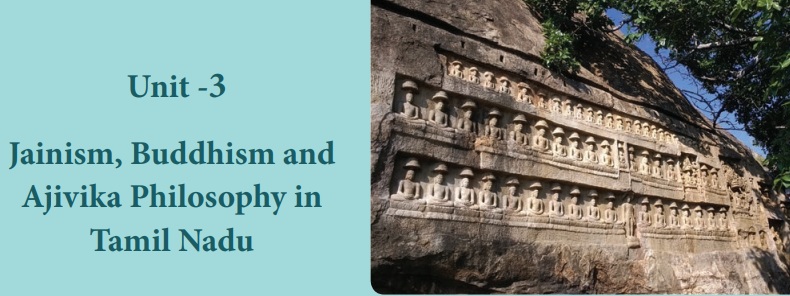
Learning Objectives
• To know the sources and literature of
heterodox religious sects: Jainism, Buddhism and Ajivikam
• To gain knowledge of the teachings of
Mahavira, Buddha and Gosala, the founder of Ajivika sect.
• To acquaint ourselves with the monuments of the above-mentioned religious sects in Tamil Nadu.
Jainism
in Tamil Nadu
Introduction
During the 6th century B.C. (BCE),
according to the Bigha Nitaya (an ancient Buddhist tract), as many as 62
different philosophical and religious schools flourished in India. However,
among these numerous sects, only the Ajivikas survived till the late medieval
times. But Jainism and Buddhism continued to flourish until the modern times.
Buddha and Mahavira, the founders of these two faiths, based their ethical
teachings against the sacrificial cult of the Vedic religion. Their teachings
were preserved and passed on through monks, who were drawn from various social
groups.
Sources and
Literature: Jainism
Mahavira's preaching was orally
transmitted by his disciples over the course of about one thousand years. In
the early period of Jainism, monks strictly followed the five great vows of
Jainism. Even religious scriptures were considered possessions and therefore
knowledge of the religion was never documented. Two hundred years after the
attainment of nirvana (death) of Mahavira, Jain scholars attempted to
codify the canon by convening an assembly at Pataliputra. It was the first Jain
council to debate the issue, but it ended as a failure because the council
could not arrive at a unanimous decision in defining the canon. A second
council held at Vallabhi, in the 5th century A.D., was, however, successful in
resolving the differences. This enabled the scholars of the time to explain the
principles of Jainism with certainty. Also, over time, many learned monks,
older in age and rich in wisdom, had compiled commentaries on various topics
pertaining to the Jain religion. Around 500 A.D. (CE) the Jain acharyas
(teachers) realised that it was extremely difficult to keep memorising the
entire Jain literature complied by the many scholars of the past and present.
In fact, significant knowledge was already lost and the rest was tampered with
modifications. Hence, they decided to document the Jain literature as known to
them
Five Great Vows of Jainism: 1. Non-violence – Ahimsa; 2. Truth–
Satya; 3. Non-stealing – Achaurya; 4. Celibacy/Chastity – Brahmacharya; 5.
Non-possession – Aparigraha.
A major split occurred in Jainism
(1st century B.C.), giving rise to two major sects, namely Digambaras
and Swetambaras. Both the Digambaras and the Swetambaras
generally acknowledge the Agama Sutras to be their early literature,
while they do differ with regard to their content and interpretation.
Jain Literature
Jain literature is generally
classified into two major categories.
1. Agama Sutras
Agama
Sutras consists of many sacred books of the Jain religion. They have been
written in the Ardha-magadhi Prakrit language. Containing the direct preaching
of Mahavira, consisting of 12 texts, they were originally compiled by immediate
disciples of Mahavira. The 12th Agama Sutra is said to have been lost.
2. Non-Agama Literature
Non-Agama
literature includes commentary and explanation of Agama Sutras, and independent
works, compiled by ascetics and scholars. They are written in many languages such as Prakrit,
Sanskrit, old Marathi, Rajasthani, Gujarati, Hindi, Kannada, Tamil, German and
English. Recognition was given to 84 books, and among them, there are 41
sutras, 12 commentaries and one Maha Bhasya or great commentary. The 41
sutras include 11 Angas (scriptures followed by Swetambaras),
12 Upangas (instructions manuals), five Chedas (rules of conduct
for the monks), five Mulas (basic doctrine of Jainism) and eight
miscellaneous works, such as Kalpasutra of Bhadrabahu. It is believed
that the Panchatantra has a great amount of Jain influence.
The Jainacharitha of Kalpa Sūtra is a Jain text containing
the biographies of the Jain Tirthankaras, notably Parshvanatha, founder of
Jainism as well as the first Tirthankara, and Mahavira, the last and the 24th
Tirthankara. This work is ascribed to Bhadrabahu, who along with Chandragupta
Maurya migrated to Mysore (about 296 B.C.) and settled there.
Tirthankaras are those who have
attained nirvana and made a passage from this world to the next.
In addition to these, we have some
Jain texts composed in Indian vernacular languages such as Hindi, Tamil and
Kannada. Jivaka Chintamani, a Tamil epic poem, is a good example,
composed in the tradition of Sangam literature by a Jain saint named
Tiruthakkathevar. It narrates the life of a pious king who rose to prominence
by his own merit only to become an ascetic in the end. Another scholarly work
in Tamil, Naladiyar, is also attributed to a Jain monk. Thirukkural was
composed by Tiruvalluvar, believed to be a Jain scholar.
Jains in Tamil Nadu
There is a clear evidence of the
movements of the Jains from Karnataka to the Kongu region (Salem, Erode and
Coimbatore areas), to the Kaveri Delta (Tiruchirapalli) southwards into
Pudukkottai region (Sittannavasal) and finally into the Pandya kingdom
(Madurai, Ramanathapuram and Tirunelveli districts). Tamils broadly come under Digambara
sect. It is believed that the Kalabhras were the patrons of Jainism.
The Sittanavasal Cave
Temple
Sittanavasal cave in Pudukkottai
district is located on a prominent rock that stands 70 m above the ground. It
has a natural cavern, known as Eladipattam, at one end, and a rock-cut cave
temple at the other. Behind the fenced cavern, there are 17 rock beds marked on
the floor. The stone berths aligned in rows are believed to have served as a
Jain shelter. The largest of these ascetic beds contains a Tamil-Brahmi
inscription that dates to the 2nd century B.C. There are more inscriptions in
Tamil from the 8th century A.D., bearing the names of monks. It is believed
that they should have spent their lives in isolation here.
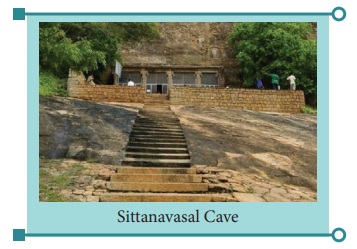
The Sittanavasal cave temple, named
Arivar Koil, lies on the west off the hillock.
The facade of the temple is simple,
with four rock-cut columns. Constructed in the early Pandya period, in the 7th
century A.D. , it has a hall in the front called the Ardha-mandapam and a
smaller cell at the rear, which is the garbha graha (sanctum sanctorum).
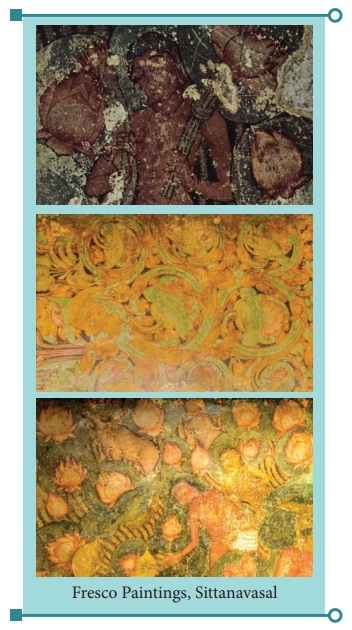
The murals in the temple resemble
the frescoes of the famous Ajanta caves. The Archaeological Survey of India
(ASI) took over the caves only in 1958. Thereafter it took two decades to cover
the cave and regulate the entry of visitors. There are the bas- relief figures
of Tirthankaras on the left wall of the hall and acharyas on the right before
one enters the inner chamber, the sanctum sanctorum.
Jains in
Kanchipuram (Tiruparuttikunram)
Jainism
flourished during the Pallava reign. In hiswritings,Chinesetraveller Hiuen
Tsang has mentioned about the presence of a large number of Buddhists andJains
during his visit to the Pallava country in 7th century A.D. Most of the Pallava
rulers were Jains. Mahendravarman was a Jain initially. The two Jain temples in
Kanchipuram are Trilokyanatha Jinaswamy Temple at Tiruparuttikunram, on the
banks of the river Palar, and the Chandra Prabha temple dedicated to the
Tirtankara named Chandraprabha. The architecture of these temples is in Pallava
style, but it has deteriorated in due course of time. During the Vijayanagar
rule (1387), Irugappa, a disciple of Jaina-muni Pushpasena; and a minister of
Vijayanagar King Harihara II (1377-1404), expanded the Trilokyanatha Temple by
adding the Sangeetha mandapa. The grand murals were added only at this time.
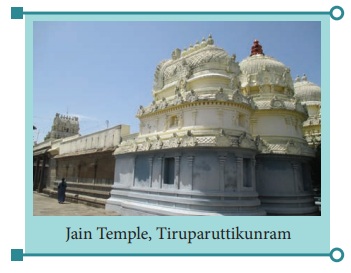
Mural paintings in the temples show
scenes from the lives of Tirtankaras. Unfortunately the paintings of the
Trilokyanatha temple at Tiruparuttikunram have been ruined by over-painting
done during renovation. There is rich inscriptional evidence inside the second
shrine, the Trikuda Basti, containing information on the development of the
temple, and the contributions of various donors over the centuries.
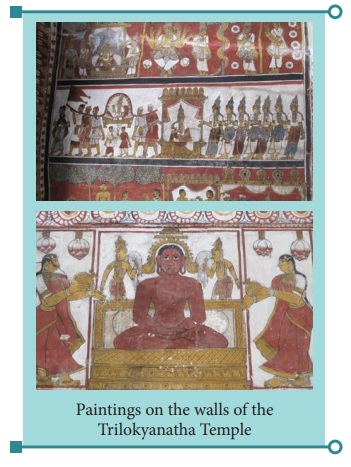
In the Kanchipuram district, apart
from Tiruparuttikunram, Jain vestiges have been found over the years in many
villages across the state.
The total population of Jains
in Tamil Nadu is 83,359 or 0.12 per cent of the population as per the 2011
census.
Kazhugumalai
Jain Rock-Cut Temple
The
8th centuryKazhugumalai temple in Kovilpatti taluk inThoothukudi district marks
the revival of Jainism in Tamil Nadu.This cave temple was built by King
Parantaka Nedunjadaiyan of the Pandyankingdom. Polished rock-cut cave beds, popularly known as Panchavar
Padukkai at Kazhugumalai cavern host the figures of not only the Tirtankaras
but also the figures of yakshas and yakshis (Male and Female
attendants respectively).

Jain Temples in other
parts of Tamil NaduVellore
Fourteen Jain monk beds, dating back
to the 5th century A.D., have been excavated inside three caverns on top of a
hill in Vellore district. The beds are found at the Bhairavamalai in Latheri,
Katpadi taluk, Vellore district. Of the three caverns, two of them house beds.
One houses four rock beds while the other houses one bed. Unlike many rock beds
found elsewhere, these ones have no head-rests.
Tirumalai
Tirumalai
is a Jain temple in a cave complex located near Arni town in Tiruvannamalai
district in Tamil Nadu. The complex, dated to the 12th century A.D., includes
three Jain caves, two Jain temples and a 16-metre-high sculpture of Neminatha,
the 22nd Tirthankara. This image of Neminatha is considered to be the tallest
Jain image in Tamil Nadu.
Madurai
There
are 26 caves, 200 stone beds, 60 inscriptions and over 100 sculptures in and
around Madurai. The Kizha Kuyil Kudi is a striking example. This hillock is 12
kilometres west of Madurai, on the Madurai–Theni Highway. The sculptures are
assigned to the period of Parantaka Veera Narayana Pandyan who ruled from A.D.
860 to 900. There are eight sculptures. The images of Rishab Nath or Adinath,
Mahavira, Parshvanath and Bahubali are found here.
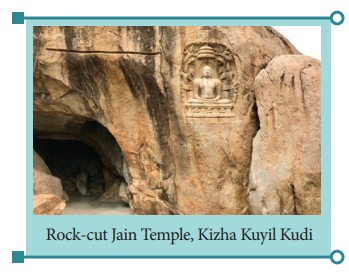
Contribution to
Education
Jaina monasteries and temples also
served as seats of learning. Education was imparted in these institutions to the
people irrespective of caste and creed. The Jainas propagated their doctrines
and proved to be a potential media of mass education. The Bhairavamalai we have
mentioned earlier is situated near a small village called Kukkara Palli.
‘Palli’ is an educational centre of Jains and villages bearing the suffix of
Palli are common in many places in Tamil Nadu.
The educational institutions had
libraries attached to them. Several books were written by the preachers of
Jainism, highlighting the important aspects of Jainism. The permission for
women to enter into the order provided an impetus to the spread of education
among women.
Related Topics